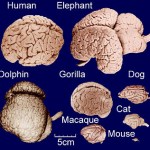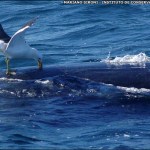Image of a fin whale by Aqqa Rosing-Asvid via Wikimedia Commons
Fin whales have big mouths, really big mouths. When your meals consist of tiny krill, it is understandable why you would evolve the ability to stretch your mouth super-wide.
Fin whale dinner. Image by Øystein Paulsen via Wikimedia Commons.
With each meal comes a lot of water, which expands a pouch in the bottom of their mouths. As the pouch expands, all of the tissues in the pouch expand as well including blood vessels and nerves. Stretchy nerves caught the interest of of Dr. Margo Lillie who…
whale
Professor Wayne Vogl and colleagues at the University of British Columbia discovered that rorqual whales can gulp volumes of water that are bigger than their body. Nerves in the mouth and tongue make this amazing feat possible as they can actually stretch to twice their resting length without sustaining damage. Dr. Vogl was quote in CBC News saying, "The nerves that supply these remarkably expandable tissues in the floor of the mouth of rorqual whales ... are very stretchy, they're like bungee cords." This is unusual as the nerves of most vertebrate species have…
Rescuers have been successful in coaxing some of the stranded pilot whales to deeper waters in the Everglades National Park (Florida). However this success is still marred by tragedy as eleven animals are now confirmed dead.
It is currently unclear why the whales beached themselves. Researchers are exploring many potential reasons including changing ocean currents and water temperatures as well as possible infections with Morbillivirus.
The situation remains tense as the animals that were led to deeper waters may return and end up stranded once again.
Image of the 52 Hertz whale song from Wikimedia Commons, NOAA.
According to Discovery News, scientists and filmmakers are on the hunt for what people have called the Loneliest Whale in the World.
In 1989 William Watkins (Woods Hole Oceanographic Institution) discovered the vocalizations of a whale that were unlike that of any other whale. The vocalizations of the mystery whale were 52 Hertz whereas other whales sing in the 17-18 Hertz range, allowing their songs to travel far distances. Beginning in 1992, he and his team started tracking the movements of the 52 Hertz whale using…
You may recall a prior blog in which I talked about the wonders of whale poo and a substance called ambergris that can be either defecated or regurgitated by whales and is used to make expensive perfumes. Well, my favorite comic strip, Piled Higher and Deeper (i.e. PhD Comics), posted a 2-minute thesis presented by Baillie Redfern from the University of British Columbia on how whale barf is used in perfumes and how her research is attempting to re-create the wonders of ambergris in the lab.
These 2-minute thesis presentations are great. Keep it up PhD Comics!
The National Institutes of Health announced that by 2011 it will transfer almost two hundred chimpanzees from the Alamogordo Primate Facility in New Mexico to a lab in San Antonio, Texas, lab for use in invasive research. In 1995, the NIH announced a moratorium on the breeding of chimps in federally-supported labs, and as a result, scientists have developed alternative ways to investigate diseases. But there are still viruses, such as hepatitis C and HIV, that other species simply can't contract. This fact, some argue, makes it prudent to subject chimps to this sort of biomedical testing.…
Last month a pod of orcas was found off of Palos Verdes, near Los Angeles.
Well, they're back. Actually, it isn't clear if this is the same pod or not, but here's some more awesome footage of orcas found in the waters off of Dana Point, earlier this week.
Killer whales are not seen often in these waters, so this is particularly exciting for those who got to see them...though it makes me wonder if they're not trying to find new hunting grounds. Is there a shortage of orca food in their normal hang-outs?
(click through to see the videos, behind the cut)
And some more footage of the whales near…
The perspective that whales, dolphins, and other such marine mammals should be afforded "human rights" has surfaced again.
I thought I'd revisit a post I wrote about this several months ago, from the archives, when this first hit the news after the AAAS conference in San Diego. So here's a modified, updated version of the original post.
The blogosphere is all a-twitter with talk of the recent commentary in Science that dolphins should be considered people. Well, sort of people. Non-human people.
On the heels of the incident at SeaWorld in Florida in which a trainer was killed by one of the…
Though they are routinely found in the waters off of California, large marine mammals like killer whales don't usually come so close to shore - it seems they prefer to stick to the farther side of the channel islands.
But yesterday, a small pod of killer whales was found in the waters between Palos Verdes and Santa Catalina Island.
KABC-TV had some nice footage of the pod:
Can't see this embedded video? Click here to watch!
Amazing that this comes on the same day that a lone grey whale was spotted in the Mediterranean Sea, off the coast of Tel Aviv!
(h/t: LAist)
I feel like I have been run over by a truck. Between blogging, working on my book, fieldwork, pitching freelance articles, and research, I just didn't have the energy to come up with something new today. Instead enjoy this post, written a little more than a year ago, about how the hip of a fossil whale was mistaken for the shoulders of an ancient bird. -- Brian
The right hip of Basilosaurus as seen in Lucas' 1900 description.
If you were a 19th century paleontologist and you wanted a skeleton of the fossil whale Basilosaurus, there was only one place to look; Alabama. Even though fossils…
Earlier this week we talked about how to use whale snot for science.
I especially enjoyed blog bff Scicurious's take on the study:
Budgetary requirement: $5000 for series of expensive remote control helicopters.
Source: Toys R Us.
Justification: Need something that can fly close to a whale and collect snot for measurement. Also, this is the only kind that comes in red, and the gunmetal grey ones suck.
This day, however, we will travel farther, er, south. Through the mouth, down the esophagus, into the stomach, detour through the intestines, take a left at the sphincter, but, what, what's…
Figure 1: Humpback whale
The question is: what do you use to study the health of whales in the wild?
The answer is: not what you'd think.
Unlike smaller sea mammals like seals or sea lions, it is very hard to obtain blood samples from whales without first killing them.
Meet Karina Acevedo-Whitehouse, from the Zoological Society of London. She studies whale health, but has had to rely on dead, stranded or captive animals for blood samples, which are hardly representative of whales in the wild.
Figure 2: Dr. Karina Acevedo-Whitehouse
So what's the next best thing to whale blood? Well, SNOT,…
As I mentioned in today's post, dead whales provide food and homes for a variety of marine organisms, and this video (uploaded by Kevin Zelnio of Deep Sea News) shows how whale fall communities change over time. It was produced by the laboratory of Dr. Craig Smith, University of Hawaii.The bone-dwelling worms I wrote about can be seen starting at the one minute mark.
The fail whale comes to rest; the decomposing body of a gray whale is host to a diverse array of scavengers and other deep sea organisms. From Goffredi et al., 2004.
In the deep sea, no carcass goes to waste. Platoons of crabs, fish, and other scavengers make short work of most of the bodies which come to rest on the sea bottom, but every now and then the carrion-eaters are presented with a rotting bonanza; a whale fall. Muscle, viscera, blubber, and bone; it all gets broken down, but it takes so long that the whale carcass actually provides a temporary home for a variety of organisms…
tags: whale, humpback whale, seabirds, Whale Versus Bird, Vancouver Aquarium, British Columbia, education, streaming video
Imagine you're a bird, you're minding your own business, leading your flock, when out of nowhere -- Humpback Whale tail! Either the Humpback has a serious dislike for birds, or while feeding this coincidence occurred. This video was shot in Juan Perez Sound, British Columbia, within the boundaries of Gwaii Haanas National Park and Haida Heritage Site.
Hat tip to my spouse, Bob O'Hara, who is celebrating his birdday today. Be sure to give him the gift of a cheap thrill by…
The natural world is rife with leftovers. Over the course of evolution, body parts that no longer benefit their owners eventually waste, away leaving behind shrivelled and useless anatomical remnants. The human tailbone is one such example. Others include the sightless eyes of cavefish that live in total darkness, the tiny spurs on boas and pythons that hint at the legs of their ancestors, and the withered wings of the Galapagos cormorant, an animal that dispensed with flight on an island bereft of land predators.
Animal genomes contain similar remains. Just like organs, genes also waste…
While we're on the topic of whales, I've got something a little less whimsical for you all to suck on. Seagulls off the coast of Argentina have recently learned in large numbers how to attack Southern right whales when they come up to breathe at the surface of the water. When the whales emerge, the seagulls land on their backs and peck at their skin, opening up huge cankerous sores which then can become infected.
This seagull claimed to be conducting "scientific research" when questioned.
Big whoop, you yawn. But according to researchers, seagull attacks on these whales is up from 1% in…
Nine years ago, a team of fossil-hunters led by Philip Gingerich from the University of Michigan uncovered something amazing - the petrified remains of an ancient whale, but one unlike any that had been found before. Within the creature's abdomen lay a collection of similar but much smaller bones. They were the fossilised remains of a foetal whale, perfectly preserved within the belly of its mother. Gingerich says, "This is the 'Lucy' of whale evolution."
The creatures are new to science and Gingerich have called them Maiacetus inuus. The genus name is an amalgamation of the Greek words "…
The tiny, 3.5 ft. long helicopters in the video below hover over sperm whales as they spew air, mucus and other gases out of their blowholes. The helicopters are covered in petri dishes which collect samples of the slimy, gooey, gaseous emissions which can then be used to test the health of individual whales and overall whale populations.
The technique was designed by Dr. Karina Acevedo-Whitehouse, a Post-doctoral Research Fellow at the Zoological Society of London. In an article in the Telegraph , she explains, "Scientists have always found it difficult to study diseases in whales because…
One of the Vancouver Aquarium's resident belugas, Qila, gave birth to a healthy calf back in June. Now four months old, the calf is beginning to play with her trainers and especially enjoys tongue rubs, which the aquarium staff say is kind of like a massage... for your tongue...
From the video info section: "Look closely for her frilly tongue. It helps forms a tight seal while she's nursing. Beluga calves don't suckle; instead, the mother squirts milk into her calf's mouth.
The calf will have a name by the end of October. Her name will be chosen from entries to the Aquarium's Name the Baby…



